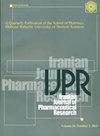A Mechanistic Study on the Fluidization and Enhancement Effects of Cineole Toward Stratum Corneum Intercellular Lamellar Lipids: A Liquid Crystalline Model Approach
IF 1.8
4区 医学
Q3 PHARMACOLOGY & PHARMACY
引用次数: 0
Abstract
Background: The stratum corneum (SC) serves as the primary barrier for permeation in human skin. Penetration enhancers, such as 1,8-cineole, are utilized to enhance the permeation of drugs. Cineole increases the permeation of chemicals through different mechanisms. However, its mechanism, particularly at high concentrations, has not been well-studied and is the subject of the present investigation. Objectives: In continuation of our previous studies, the present investigation aims to elucidate the mechanism of action and concentration dependency of the effects of 1,8-cineole on the structure, diffusional properties, and partitioning behavior of the SC at high concentrations. This will be achieved through lamellar liquid crystalline models and ex-vivo skin studies. Methods: A lamellar liquid crystalline lipid matrix model in the presence (25 - 90%, w/w) and absence of cineole was prepared from SC lipids and characterized by X-ray diffraction, differential scanning calorimetry (DSC), thermogravimetric analysis (TGA), and polarized light microscopy (PLM) studies. Release of the model lipophilic drug (diazepam) from cineole and cineole-treated matrices and the permeation of the drug from cineole and cineole-containing matrices (as a vehicle similar to the stratum corneum lipids) through excised rat skin were studied. Drug assay was performed by HPLC. Results: The PLM, DSC, and X-ray studies showed that the model matrix had a lamellar gel-liquid crystalline structure, and cineole fluidized the structure concentration-dependently and created other mesomorphic textures, such as myelinic figures. Release experiments showed that diffusion coefficients remained almost constant at high cineole concentrations of 40-90%, suggesting similar fluidization states. Skin permeation studies indicated that the diffusion coefficient (estimated from lag-time) increased concentration-dependently and played a role in permeability coefficient (Kp) increments alongside the increased partitioning of the model drug into the skin. Data suggest that high concentrations of cineole at the skin surface might not provide enough cineole in the skin for full fluidization, despite the similarity of the vehicle to SC lipids and even at high concentrations. Conclusions: The enhancement effect of cineole is concentration-dependent and might reach maximum fluidization at certain concentrations, but this maximum might not be easily achievable when cineole is used in formulations as pure or in a vehicle.桉叶脑对角质层细胞间层状脂质流化和增强作用的机理研究:液晶模型方法
背景:角质层(SC)是人体皮肤渗透的主要屏障。渗透促进剂,如1,8-桉树脑,被用来增强药物的渗透。桉树脑通过不同的机制增加化学物质的渗透。然而,其机制,特别是在高浓度时,尚未得到充分研究,这是本研究的主题。目的:在我们之前研究的基础上,本研究旨在阐明1,8-桉树脑在高浓度下对SC结构、扩散特性和分配行为影响的作用机制和浓度依赖性。这将通过层状液晶模型和离体皮肤研究来实现。方法:以SC脂质为原料制备了桉树脑存在(25 - 90%,w/w)和不存在(25 - 90%,w/w)的片层状液晶脂质基质模型,并通过x射线衍射、差示扫描量热法(DSC)、热重分析(TGA)和偏光显微镜(PLM)对其进行了表征。研究了模型亲脂性药物(安定)从桉叶脑和桉叶脑处理的基质中释放,以及药物从桉叶脑和含桉叶脑的基质(作为类似于角质层脂质的载体)通过切除的大鼠皮肤的渗透。HPLC法测定药物含量。结果:PLM、DSC和x射线研究表明,该模型基质具有层状凝胶-液晶结构,桉树脑对该结构进行了浓度依赖性流化,并产生了其他中形态织构,如髓鞘图形。释放实验表明,在桉树脑浓度为40-90%时,扩散系数基本保持不变,表明流体化状态相似。皮肤渗透研究表明,扩散系数(从滞后时间估计)随浓度的增加而增加,并在渗透系数(Kp)增量中发挥作用,同时增加模型药物进入皮肤的分配。数据表明,皮肤表面高浓度的桉树脑可能无法在皮肤中提供足够的桉树脑来实现完全流化,尽管载体与SC脂质相似,甚至在高浓度下也是如此。结论:桉树脑的增强作用是浓度依赖性的,在一定浓度下可能达到最大流化,但当桉树脑作为纯制剂或在载体中使用时,可能不容易达到最大流化。
本文章由计算机程序翻译,如有差异,请以英文原文为准。
求助全文
约1分钟内获得全文
求助全文
来源期刊
CiteScore
3.40
自引率
6.20%
发文量
52
审稿时长
2 months
期刊介绍:
The Iranian Journal of Pharmaceutical Research (IJPR) is a peer-reviewed multi-disciplinary pharmaceutical publication, scheduled to appear quarterly and serve as a means for scientific information exchange in the international pharmaceutical forum. Specific scientific topics of interest to the journal include, but are not limited to: pharmaceutics, industrial pharmacy, pharmacognosy, toxicology, medicinal chemistry, novel analytical methods for drug characterization, computational and modeling approaches to drug design, bio-medical experience, clinical investigation, rational drug prescribing, pharmacoeconomics, biotechnology, nanotechnology, biopharmaceutics and physical pharmacy.

 求助内容:
求助内容: 应助结果提醒方式:
应助结果提醒方式:


